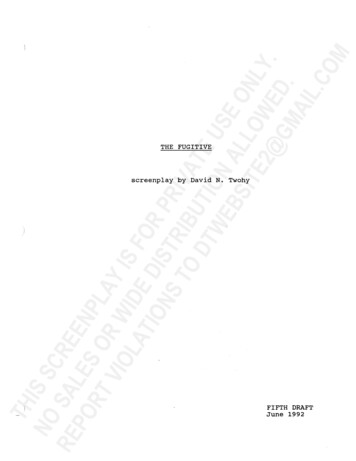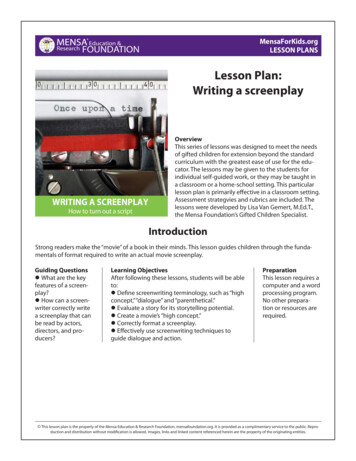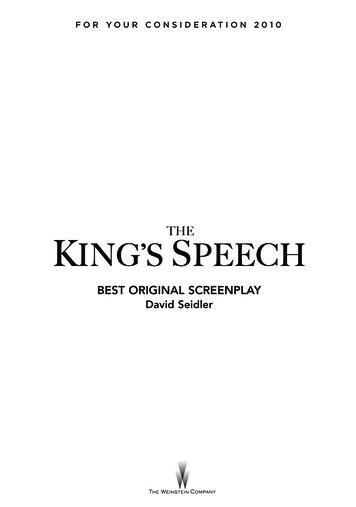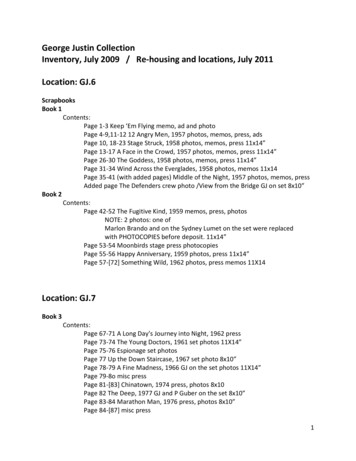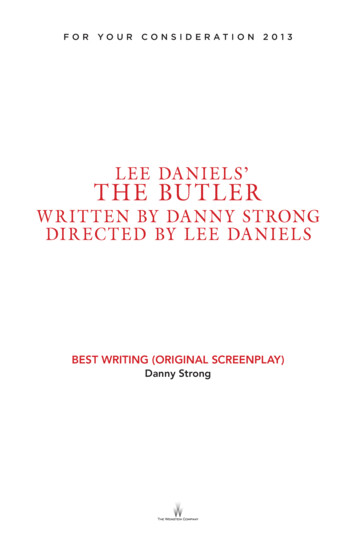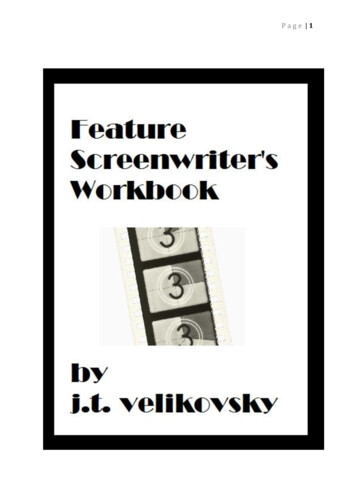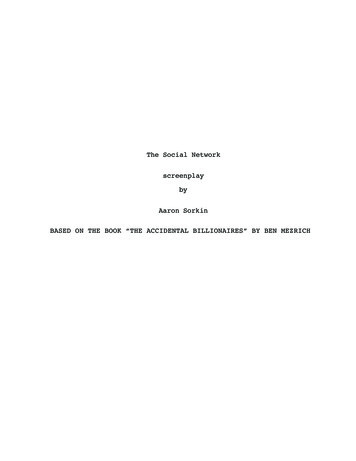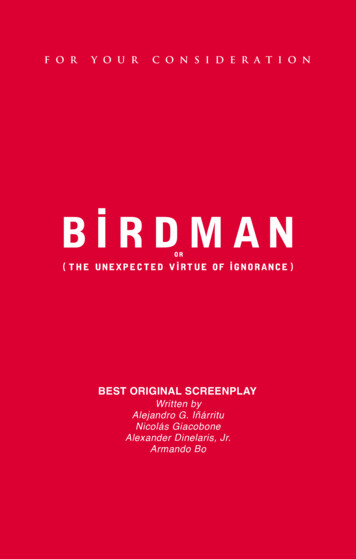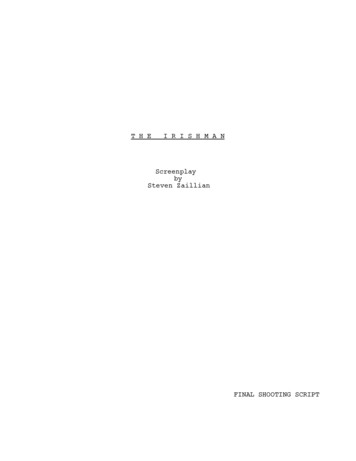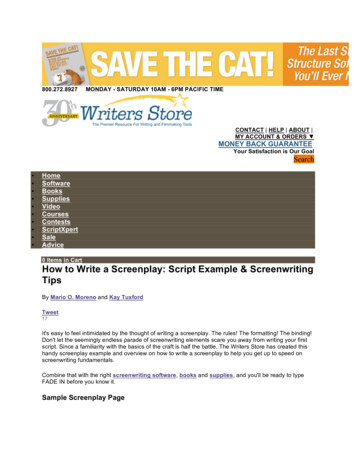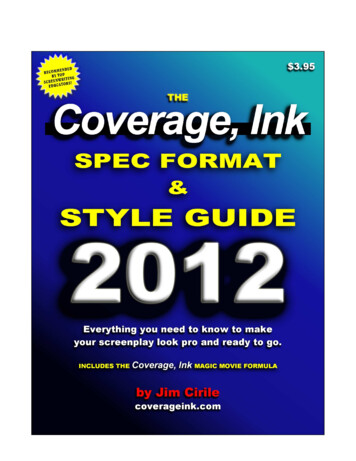
Transcription
800.272.8927MONDAY - FRIDAY 8AM - 5PM MOUNTAIN TIMEMONEY BACK GUARANTEEYour Satisfaction is Our GoalHow to Write a Screenplay: Script Writing Example & Screenwriting TipsBy Mario O. Moreno and Kay TuxfordTweetLike 496Save757It's easy to feel intimidated by the thought of writing a screenplay. The rules! The formatting! The binding! Don't let the seemingly endless parade ofscreenwriting elements scare you away from writing your first script. Since a familiarity with the basics of the craft is half the battle, The Writers Store hascreated this handy screenplay example and overview on how to write a screenplay to help you get up to speed on screenwriting fundamentals.Combine that with the right screenwriting software, books and supplies, and you'll be ready to type FADE IN before you know it.Sample Screenplay Page
Recommended Screenwriting Software for Writing a Screenplay
What is a Screenplay?In the most basic terms, a screenplay is a 90-120 page document written in Courier 12pt font on 8 1/2" x 11" bright white three-hole punched paper.Wondering why Courier font is used? It's a timing issue. One formatted script page in Courier font equals roughly one minute of screen time. That's why theaverage page count of a screenplay should come in between 90 and 120 pages. Comedies tend to be on the shorter side (90 pages, or 1 ½ hours) whileDramas run longer (120 pages, or 2 hours).A screenplay can be an original piece, or based on a true story or previously written piece, like a novel, stage play or newspaper article. At its heart, ascreenplay is a blueprint for the film it will one day become. Professionals on the set including the producer, director, set designer and actors all translate thescreenwriter's vision using their individual talents. Since the creation of a film is ultimately a collaborative art, the screenwriter must be aware of eachperson's role and as such, the script should reflect the writer's knowledge.For example, it's crucial to remember that film is primarily a visual medium. As a screenwriter, you must show what's happening in a story, rather than tell. A2-page inner monologue may work well for a novel, but is the kiss of death in a script. The very nature of screenwriting is based on how to show a story on ascreen, and pivotal moments can be conveyed through something as simple as a look on an actor's face. Let's take a look at what a screenplay's structurelooks like.The First Page of a ScreenplayWhile screenplay formatting software such as Final Draft, Movie Magic Screenwriter, Movie Outline and Montage frees you from having to learn thenitty-gritty of margins and indents, it's good to have a grasp of the general spacing standards.The top, bottom and right margins of a screenplay are 1". The left margin is 1.5". The extra half-inch of white space to the left of a script page allows forbinding with brads, yet still imparts a feeling of vertical balance of the text on the page. The entire document should be single-spaced.The very first item on the first page should be the words FADE IN:. Note: the first page is never numbered. Subsequent page numbers appear in the upperright hand corner, 0.5" from the top of the page, flush right to the margin.Screenplay ElementsBelow is a list of items (with definitions) that make up the screenplay format, along with indenting information. Again, screenplay software will automaticallyformat all these elements, but a screenwriter must have a working knowledge of the definitions to know when to use each one.Scene HeadingIndent: Left: 0.0" Right: 0.0" Width: 6.0"A scene heading is a one-line description of the location and time of day of a scene, also known as a "slugline." It should always be in CAPS.Example: EXT. WRITERS STORE - DAY reveals that the action takes place outside The Writers Store during the daytime.SubheaderIndent: Left: 0.0" Right: 0.0" Width: 6.0"When a new scene heading is not necessary, but some distinction needs to be made in the action, you can use a subheader. But be sure to use thesesparingly, as a script full of subheaders is generally frowned upon. A good example is when there are a series of quick cuts between two locations, you woulduse the term INTERCUT and the scene locations.ActionIndent: Left: 0.0" Right: 0.0" Width: 6.0"The narrative description of the events of a scene, written in the present tense. Also less commonly known as direction, visual exposition, blackstuff,description or scene direction.Remember - only things that can be seen and heard should be included in the action.CharacterIndent: Left: 2.0" Right: 0.0" Width: 4.0"When a character is introduced, his name should be capitalized within the action. For example: The door opens and in walks LIAM, a thirty-something hipsterwith attitude to spare.A character's name is CAPPED and always listed above his lines of dialogue. Minor characters may be listed without names, for example "TAXI DRIVER" or"CUSTOMER."DialogueIndent: Left: 1.0" Right: 1.5" Width: 3.5"Lines of speech for each character. Dialogue format is used anytime a character is heard speaking, even for off-screen and voice-overs.ParentheticalIndent: Left: 1.5" Right: 2.0" Width: 2.5"A parenthetical is direction for the character, that is either attitude or action-oriented. With roots in the playwriting genre, today, parentheticals are used veryrarely, and only if absolutely necessary. Why? Two reasons. First, if you need to use a parenthetical to convey what's going on with your dialogue, then itprobably just needs a good re-write. Second, it's the director's job to instruct an actor on how to deliver a line, and everyone knows not to encroach on thedirector's turf!
ExtensionPlaced after the character's name, in parenthesesAn abbreviated technical note placed after the character's name to indicate how the voice will be heard onscreen, for example, if the character is speaking asa voice-over, it would appear as LIAM (V.O.).TransitionIndent: Left: 4.0" Right: 0.0" Width: 2.0"Transitions are film editing instructions, and generally only appear in a shooting script. Transition verbiage includes:CUT TO:DISSOLVE TO:SMASH CUT:QUICK CUT:FADE TO:As a spec script writer, you should avoid using a transition unless there is no other way to indicate a story element. For example, you might need to useDISSOLVE TO: to indicate that a large amount of time has passed.ShotIndent: Left: 0.0" Right: 0.0" Width: 6.0"A shot tells the reader the focal point within a scene has changed. Like a transition, there's rarely a time when a spec screenwriter should insert shotdirections. Once again, that's the director's job.Examples of Shots:ANGLE ON -EXTREME CLOSE UP -PAN TO -LIAM'S POV --Recommended Books for Writing a ScreenplaySpec Script vs. Shooting ScriptA "spec script" literally means that you are writing a screenplay on speculation. That is, no one is paying you to write the script. You are penning it in hopes ofselling the script to a buyer. Spec scripts should stick stringently to established screenwriting rules.Once a script is purchased, it becomes a shooting script, also called a production script. This is a version of the screenplay created for film production. It willinclude technical instructions, like film editing notes, shots, cuts and the like. All the scenes are numbered, and revisions are marked with a color-codedsystem. This is done so that the production assistants and director can then arrange the order in which the scenes will be shot for the most efficient use ofstage, cast, and location resources.A spec script should NEVER contain the elements of shooting script. The biggest mistake any new screenwriter can make is to submit a script full ofproduction language, including camera angles and editing transitions. It can be very difficult to resist putting this type of language in your script. After all, it'syour story and you see it in a very specific way. However, facts are facts. If you want to direct your script, then try to go the independent filmmaker route. Butif you want to sell your script, then stick to the accepted spec screenplay format.Screenplay Formatting SoftwareScreenwriting software makes producing an Industry-standard script simple and straightforward. Programs like Final Draft and Movie Magic Screenwriterput your words into proper screenplay format as you type, letting you focus on a well-told story rather than the chore of margins and spacing.There’s also a wide spectrum of outlining and development software at the ready to help you get your thoughts together before you begin writing. Popularstory development software includes Dramatica Pro, a step-by-step guide to the storytelling process, Contour, a character-based structuring system, andSave the Cat!, a program centered on successful screenwriter Blake Snyder’s own proven methods.And if you want a program that combines story development and formatting? Check out Movie Outline, an all-in-one development package that uses stepoutlining to build your story, scene-by-scene, and Montage, which includes both outline and submission tracking functions.Script Presentation and Binding
Just like the format of a script, there are very specific rules for binding and presenting your script. The first page is the title page, which should also be writtenin Courier 12pt font. No graphics, no fancy pictures, only the title of your script, with “written by” and your name in the center of the page. In the lower lefthand or right-hand corner, enter your contact information. In the lower left-hand or right-hand corner you can put Registered, WGA or a copyright notification,though this is generally not a requirement.Sample Title PageBelow is a list of items you need to prepare your script to be sent out:Script Covers, either linen or standard card stockThree-Hole Punched PaperScreenplay Brass Fasteners (also called Brads), Acco number 5 size 1 1/4-inch for scripts up to 120 pages; Acco number 6 size 2-inch for largerscriptsScript Binding Mallet (optional)Screenplay Brass WashersScript MailersFollow these directions to properly bind your script:1. Print your title page and script on bright white three-hole punched paper.2. Insert the title page and the script into the script cover. The front and back covers remain blank. They are just there to protect your script. Andremember: pictures and text on script covers scream amateur.3. Insert two brass fasteners in the first and third holes. Do NOT put a fastener in the middle hole.4. Flip the script over, and slide the brass washers over the arms of the fasteners. Spread the arms of the fasteners flat against the script. Use a ScriptBinding Mallet to ensure a tight, flat fit.5. Use the flat, self-seal script mailers to send your scripts out to buyers.
Materials for Further ExplorationNow that you understand screenplay basics, you’re no doubt ready to continue your exploration of the craft and go beyond learning how to write a moviescript. The books listed below are some of The Writers Store’s favorite guides to screenwriting.The Screenwriter's Bible: A Complete Guide to Writing, Formatting, and Selling Your ScriptWondering how to write a script? This first-rate screenwriting primer provides a concise presentation of screenwriting basics, along with query letters, usefulworksheets, checklists, sample scenes and more to help you break into screenplay writing.From Script to ScreenWhat goes into the making of Hollywood's greatest motion pictures? Join Linda Seger and Edward Whetmore as they examine recent screenplays on theirjourney from script to screen.Hollywood Standard: The Complete and Authoritative Guide to Script Format and StyleThe Hollywood Standard describes in clear, vivid prose and hundreds of examples how to format every element of a screenplay or television script.Save the Cat!This ultimate insider's guide reveals the secrets that none dare admit, told by a show biz veteran who's proven that you can sell your script if you can Savethe Cat.Interested in taking a screenwriting class? Visit our courses section for webinars, live seminars, online courses, one-on-one instruction and on-demandcourses. You can download a free webinar on "How to Write a Screenplay" from magazine site, ScriptMag.com.TweetLike 496Save757Meet the Author: Mario O. MorenoMario O. Moreno is the writer/creator of Maker Studio's LA Series, executive produced and co-directed by JamesFranco. In addition to LA Series, Mario is the writer/creator/executive producer of Untitled Miami Series that wasoptioned by Franco's RabbitBandini Productions, and is currently at work on their third collaboration, a featureadaptation. Mario earned a bachelor’s degree in film from Miami International University, where he gainedexperience writing, producing, directing, and editing short films, eventually winning.Most Popular ItemsHollywood ScreenwritingDirectory - PDF Edition:Spring/Summer Edition Vol10 24.99Writing Thrillers: TheWriter's Guide to CraftingTales of Suspense - eBook(PDF) 3.9945 Master Characters:Mythic Models for CreatingOriginal Characters - eBook(Consumer PDF) 16.99The End: How to Write anAmazing Finish to YourScreenplay - OnDemandEdition 79.99Write Now: Provenapproaches for conqueringprocrastination, self-doubt,fear and perfectionism OnDemand Edition 79.99
How to Write a Screenplay: Script Writing Example & Screenwriting Tips By Mario O. Moreno and Kay Tuxford Tweet It's easy to feel intimidated by the thought of writing a screenplay. The rules! The formatting! The binding! Don't let the seemingly endless parade of screenwritin
